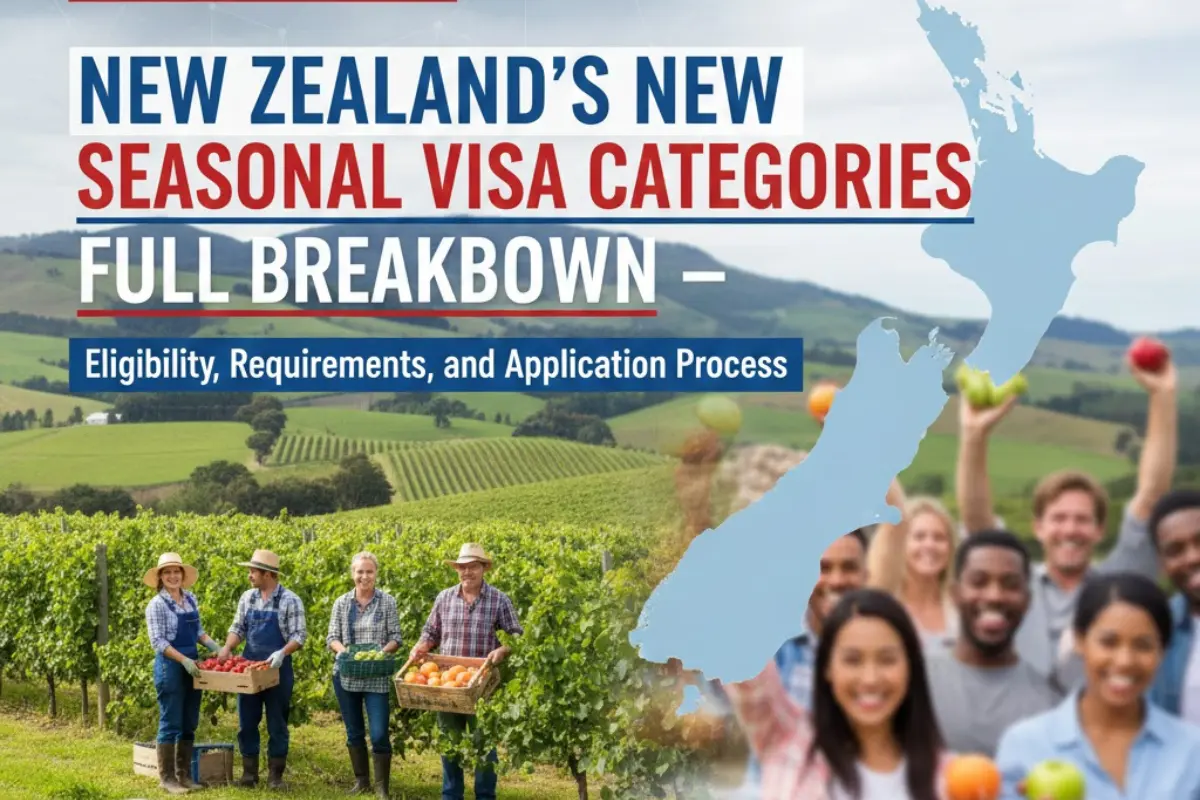
What Are New Zealand New Seasonal Visa Categories? — Full Breakdown
Table of Contents
New Zealand is launching two New Zealand New Seasonal Visa categories — the Global Workforce Seasonal Visa (GWSV) and the Peak Seasonal Visa (PSV) — to help accredited employers bring in short-term workers for real seasonal roles. These visas sit under the Accredited Employer Work Visa (AEWV) framework and applications open on 8 December 2025.
This article explains, in simple English, what the New Zealand New Seasonal Visa options mean, who they help, how to apply, and what workers and employers should expect. I’ll also point out where to Submit NZeTA Online and how to check your NZeTA Visa Status if you need an electronic travel authority. Read on — by the end you should feel ready and confident.
Why these new seasonal visas?
Some New Zealand businesses have busy seasons when they need a lot of extra people — think fruit harvests, busy summer tourism, or the ski season. The government created the New Zealand New Seasonal Visa scheme so accredited employers can hire overseas workers quickly for short, genuine seasonal jobs. The idea is simple: make hiring clearer and safer, while still giving New Zealand workers the first chance at jobs.
The two visas — quick, clear comparison
1. Global Workforce Seasonal Visa (GWSV)
This is for recurring seasonal roles where employers want the same kinds of workers across multiple seasons. The GWSV can be valid for a longer time (in some cases up to three years) but has rules like how much time a worker must spend outside New Zealand each year and minimum past seasonal experience. It is designed for people who have worked seasonally before and may return across seasons.
2. Peak Seasonal Visa (PSV)
The PSV is for short spikes in demand — a few weeks or a few months — when businesses need extra hands quickly. It is short-term and is not meant as a route to permanent residency. The PSV covers genuine short seasonal work like harvests or short processing runs.
Together these make up the New Zealand New Seasonal Visa package that sits under the AEWV rules.
Who benefits?
- Employers — farmers, packhouses, meat and seafood processors, tourism operators and ski fields can meet busy periods more reliably.
- Seasonal workers — students, backpackers, or experienced seasonal workers get clearer rules, protections, and predictable work.
- Local communities — better planning by employers can lead to better housing and local services during busy seasons.
This is why many industry groups support the New Zealand New Seasonal Visa approach: it balances real business needs with worker protections.
Who can apply — the basics
Common rules across the two visas include:
- You must have a genuine job offer from an accredited employer.
- The job must be truly seasonal — tied to a natural business cycle like harvest or peak tourism.
- You will usually need to pass health and character checks and supply standard documents (passport, references, job offer).
- Employers must show they tried to hire locally first before hiring from overseas.
If you plan to travel to or from New Zealand for short visits, remember that Submit NZeTA Online may be required for some travellers. You can check your NZeTA Visa Status online if you have requested an NZeTA.
How to apply — step by step
- Get a job offer from an accredited employer who confirms the role is seasonal.
- Employer completes a Job Check under AEWV rules and shows local recruitment attempts.
- You apply for the GWSV or PSV through Immigration New Zealand’s online system when applications open (8 Dec 2025).
- Upload documents — passport, the job offer, any proof of past seasonal work, health and character checks.
- Wait for decision and plan travel. If required, make sure to Submit NZeTA Online and confirm your NZeTA Visa Status before you fly.
Pay, rights and conditions — what to expect
Workers on a New Zealand New Seasonal Visa are covered by New Zealand employment laws. That means they should receive at least the minimum wage, proper work conditions, and the right to raise concerns if something is wrong. Employers are expected to give honest job details and reasonable accommodation if promised. These protections are central to the new rules and aim to reduce the risk of worker exploitation.
Common questions — quick answers
- Can seasonal work lead to residency?
- Usually not. These visas are for short-term seasonal work, not a direct path to permanent residency.
- How long can I stay?
- That depends on whether you have a GWSV or PSV and the job itself — check Immigration New Zealand for exact limits.
- When do applications open?
- 8 December 2025.
A few human tips (before you go)
- Ask your employer for a written job agreement with clear pay and dates.
- Keep payslips and reference letters — they help for future seasonal visa checks.
- If you need to travel in or out of NZ while on the job, Submit NZeTA Online in good time and check your NZeTA Visa Status so you don’t miss travel windows.
Final thoughts
The New Zealand New Seasonal Visa options are made to make seasonal work safer and more predictable for both employers and workers. If you are an employer, get accredited and prepare your Job Check. If you are a worker, secure a genuine offer, collect your proof of experience, and check travel rules — including whether you must Submit NZeTA Online and how to check your NZeTA Visa Status — before you book flights. If you want, I can make this into a printable checklist, a short FAQ for your blog, or a country-specific step-by-step guide.